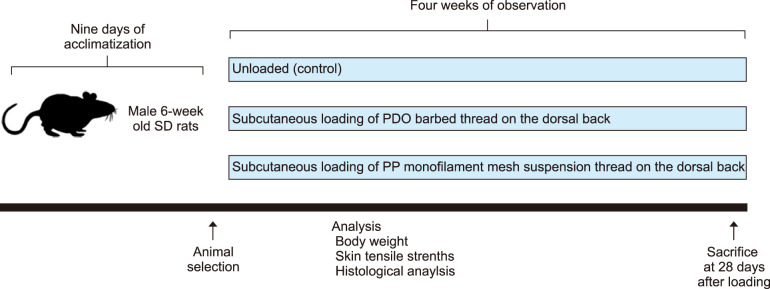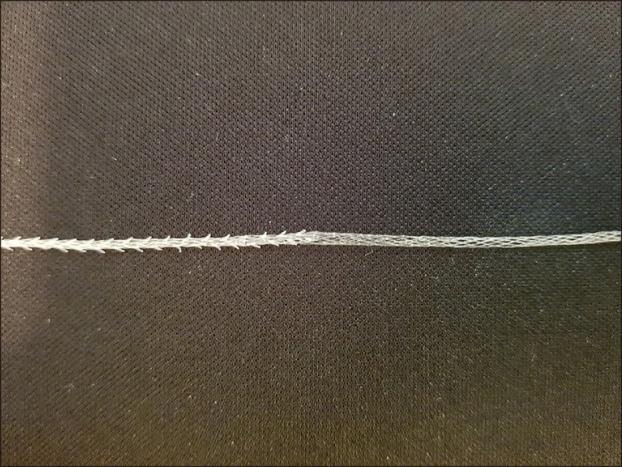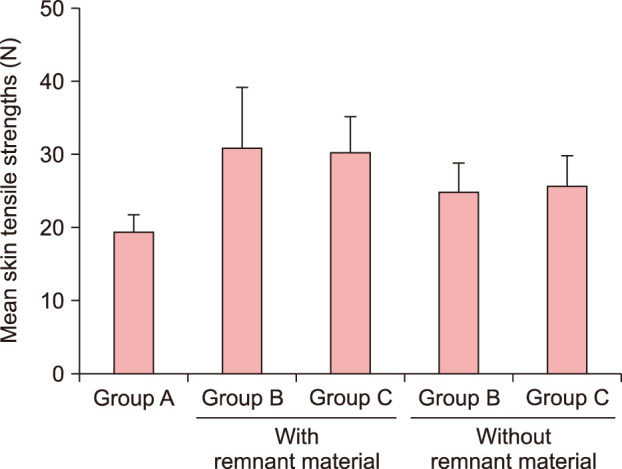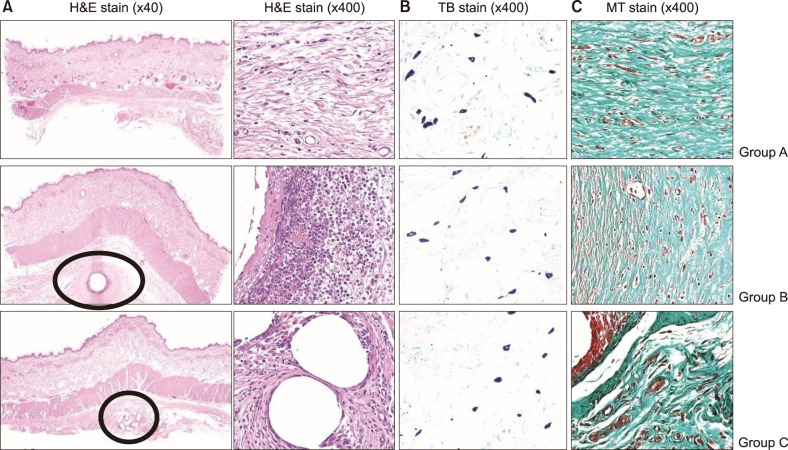Ann Dermatol.
2019 Dec;31(6):645-653. 10.5021/ad.2019.31.6.645.
Experimental Investigation on the Tissue Response Induced by Face-Lifting Mesh Suspension Thread in Rats
- Affiliations
-
- 1Department of Dermatology, Soonchunhyang University Cheonan Hospital, Soonchunhyang University College of Medicine, Cheonan, Korea.
- 2Department of Plastic Surgery, Artinu Plastic Surgery Clinic, Hwaseong, Korea.
- 3Department of Plastic and Reconstructive Surgery, Eulji General Hospital, Eulji University School of Medicine, Seoul, Korea. joaljh@eulji.ac.kr
- KMID: 2461987
- DOI: http://doi.org/10.5021/ad.2019.31.6.645
Abstract
- BACKGROUND
Face-lifting procedures are often performed to hide the effects of aging. Thread-lifting, a minimally invasive technique for the correction of facial aging, has become increasingly popular, and various materials for the procedure have been developed.
OBJECTIVE
This study compared tissue responses to two types of threading sutures placed under rat skin: polypropylene (PP) monofilament mesh suspension thread (a novel face-lifting material) and polydioxanone (PDO) barbed thread.
METHODS
Eight rats each were assigned to the PP monofilament mesh suspension, PDO barbed thread, and control groups. Tissue reactions were evaluated 28 days after subcutaneous loading of the materials.
RESULTS
Significant increases in tensile strength and the mean area occupied by collagen fibers were evident in skin loaded with PDO barbed thread and PP monofilament mesh suspension thread compared to control skin (p<0.05). Compared to sites loaded with PDO barbed thread, those loaded with PP monofilament mesh suspension thread showed a significant increase in the number of collagen fibers and a lower grade of inflammation (p<0.05).
CONCLUSION
PP monofilament mesh suspension thread has skin-rejuvenating effects comparable to those of PDO barbed thread, but induces a less severe inflammatory response. This indicates that it is a safe and effective material for use in thread-lifting procedures on aging skin.
MeSH Terms
Figure
Reference
-
1. Sulamanidze MA, Fournier PF, Paikidze TG, Sulamanidze GM. Removal of facial soft tissue ptosis with special threads. Dermatol Surg. 2002; 28:367–371. PMID: 12030865.
Article2. Nkengne A, Bertin C. Aging and facial changes--documenting clinical signs, part 1: clinical changes of the aging face. Skinmed. 2013; 11:281–286. PMID: 24340467.3. Kazinnikova OG, Adamian AA. Age-specific changes in facial and cervical tissues: a review. Ann Plast Recontr Aesthetic Surg. 2000; 1:52–61.4. Mitz V, Peyronie M. The superficial musculo-aponeurotic system (SMAS) in the parotid and cheek area. Plast Reconstr Surg. 1976; 58:80–88. PMID: 935283.
Article5. Owsley JQ. Lifting the malar fat pad for correction of prominent nasolabial folds. Plast Reconstr Surg. 1993; 91:463–474. discussion 475-466. PMID: 8438018.
Article6. Kang MS, Shin JS, Nam SM, Park ES. Evaluation of elastic lift for facial rejuvenation. Arch Aesthetic Plast Surg. 2016; 22:20–27.
Article7. Paul MD, Calvert JW, Evans GR. The evolution of the midface lift in aesthetic plastic surgery. Plast Reconstr Surg. 2006; 117:1809–1827. PMID: 16651954.
Article8. Kaminer MS, Bogart M, Choi C, Wee SA. Long-term efficacy of anchored barbed sutures in the face and neck. Dermatol Surg. 2008; 34:1041–1047. PMID: 18462425.
Article9. Derby BM, Codner MA. Evidence-based medicine: face lift. Plast Reconstr Surg. 2017; 139:151e–167e.10. Sapountzis S, Kim JH, Li TS, Rashid A, Cruz PC, Hwang YS. Successful treatment of thread-lifting complication from APTOS sutures using a simple MACS lift and fat grafting. Aesthetic Plast Surg. 2012; 36:1307–1310. PMID: 23052379.
Article11. Park TH, Seo SW, Whang KW. Facial rejuvenation with fine-barbed threads: the simple Miz lift. Aesthetic Plast Surg. 2014; 38:69–74. PMID: 23812613.
Article12. Lycka B, Bazan C, Poletti E, Treen B. The emerging technique of the antiptosis subdermal suspension thread. Dermatol Surg. 2004; 30:41–44. discussion 44. PMID: 14692925.
Article13. Abraham RF, DeFatta RJ, Williams EF 3rd. Thread-lift for facial rejuvenation: assessment of long-term results. Arch Facial Plast Surg. 2009; 11:178–183. PMID: 19451452.14. Han SE, Go JY, Pyon JK, Oh KS. A prospective evaluation of outcomes for midface rejuvenation with mesh suspension thread: “REEBORN lift”. J Cosmet Dermatol. 2016; 15:254–259. PMID: 27086766.
Article15. Lee HS, Cho HR, Yang KJ, Shin HD, Park BR, Jang HJ, et al. Local irritation test of 3 types of β-glucan after subcutaneous injection in rats. Lab Anim Res. 2006; 22:339–342.16. Drynda A, Seibt J, Hassel T, Bach FW, Peuster M. Biocompatibility of fluoride-coated magnesium-calcium alloys with optimized degradation kinetics in a subcutaneous mouse model. J Biomed Mater Res A. 2013; 101:33–43. PMID: 22767427.
Article17. Kim KH, Park SJ, Lee YJ, Lee JE, Song CH, Choi SH, et al. Inhibition of UVB-induced skin damage by exopolymers from Aureobasidium pullulans SM-2001 in hairless mice. Basic Clin Pharmacol Toxicol. 2015; 116:73–86. PMID: 24964914.18. Kim CG, Kang M, Lee YH, Min WG, Kim YH, Kang SJ, et al. Bathing effects of various seawaters on allergic (atopic) dermatitis-like skin lesions induced by 2,4-dinitrochlorobenzene in hairless mice. Evid Based Complement Alternat Med. 2015; 2015:179185. PMID: 26221169.
Article19. Levene A. Pathological factors influencing excision of tumours in the head and neck. part I. Clin Otolaryngol Allied Sci. 1981; 6:145–151. PMID: 7016380.
Article20. Ludbrook J. Update: microcomputer statistics packages. a personal view. Clin Exp Pharmacol Physiol. 1997; 24:294–296. PMID: 9131301.
Article21. Gamboa GM, Vasconez LO. Suture suspension technique for midface and neck rejuvenation. Ann Plast Surg. 2009; 62:478–481. PMID: 19387144.
Article22. Wu WT. Barbed sutures in facial rejuvenation. Aesthet Surg J. 2004; 24:582–587. PMID: 19336215.
Article23. Maschio F, Lazzaro L, Pizzamiglio R, Perego F, De Biasio F, Parodi PC. Suspension sutures in facial reconstruction: surgical techniques and medium-term outcomes. J Craniofac Surg. 2013; 24:e31–e33. PMID: 23348328.24. Shiffman MA, Mirrafati S, Lam SM, Cueteaux CG. Simplified facial rejuvenation. Berlin: Springer-Verlag;2008. p. 257.25. Pak CS, Chang LS, Lee H, Jeong JH, Jeong J, Yoon ES, et al. A multicenter noncomparative clinical study on midface rejuvenation using a nonabsorbable polypropylene mesh: evaluation of efficacy and safety. Arch Plast Surg. 2015; 42:572–579. PMID: 26430628.
Article26. Moscona RA, Ramon Y, Toledano H, Barzilay G. Use of synthetic mesh for the entire abdominal wall after TRAM flap transfer. Plast Reconstr Surg. 1998; 101:706–710. discussion 711-702. PMID: 9500387.
Article27. Sapountzis S, Nikkhah D, Kim JH, Seo JD. Novel polypropylene barbed threads for midface lift-“REEBORN Lifting”. Plast Reconstr Surg Glob Open. 2014; 2:e250. PMID: 25506533.
Article28. Kwon KA, Shipley RJ, Edirisinghe M, Ezra DG, Rose GE, Rayment AW, et al. Microstructure and mechanical properties of synthetic brow-suspension materials. Mater Sci Eng C Mater Biol Appl. 2014; 35:220–230. PMID: 24411372.
Article29. Fisher GJ, Varani J, Voorhees JJ. Looking older: fibroblast collapse and therapeutic implications. Arch Dermatol. 2008; 144:666–672. PMID: 18490597.30. Quan T, Shao Y, He T, Voorhees JJ, Fisher GJ. Reduced expression of connective tissue growth factor (CTGF/CCN2) mediates collagen loss in chronologically aged human skin. J Invest Dermatol. 2010; 130:415–424. PMID: 19641518.
Article31. Treiber N, Maity P, Singh K, Ferchiu F, Wlaschek M, Scharffetter-Kochanek K. The role of manganese superoxide dismutase in skin aging. Dermatoendocrinol. 2012; 4:232–235. PMID: 23467724.
Article32. Egbert M, Ruetze M, Sattler M, Wenck H, Gallinat S, Lucius R, et al. The matricellular protein periostin contributes to proper collagen function and is downregulated during skin aging. J Dermatol Sci. 2014; 73:40–48. PMID: 24055232.
Article33. Argyropoulos AJ, Robichaud P, Balimunkwe RM, Fisher GJ, Hammerberg C, Yan Y, et al. Alterations of dermal connective tissue collagen in diabetes: molecular basis of age-dappearing skin. PLoS One. 2016; 11:e0153806. PMID: 27104752.
Article34. Chang L, Liu XL, Di Fan D, Miao YQ, Zhang H, Ma HP, et al. The efficiency of magnetic hyperthermia and in vivo histocompatibility for human-like collagen protein-coated magnetic nanoparticles. Int J Nanomedicine. 2016; 11:1175–1185. PMID: 27042065.35. van Essen TH, van Zijl L, Possemiers T, Mulder AA, Zwart SJ, Chou CH, et al. Biocompatibility of a fish scale-derived artificial cornea: cytotoxicity, cellular adhesion and phenotype, and in vivo immunogenicity. Biomaterials. 2016; 81:36–45. PMID: 26717247.36. Pereira-Lucena CG, Artigiani Neto R, de Rezende DT, Lopes-Filho Gde J, Matos D, Linhares MM. Early and late postoperative inflammatory and collagen deposition responses in three different meshes: an experimental study in rats. Hernia. 2014; 18:563–570. PMID: 24370605.
Article37. Pascual G, Rodríguez M, Sotomayor S, Pérez-Köhler B, Bellón JM. Inflammatory reaction and neotissue maturation in the early host tissue incorporation of polypropylene prostheses. Hernia. 2012; 16:697–707. PMID: 22744412.
Article
- Full Text Links
- Actions
-
Cited
- CITED
-
- Close
- Share
- Similar articles
-
- Minimally invasive facial rejuvenation combining thread lifting with liposuction: A clinical comparison with thread lifting alone
- Case report of unusual complication following thread lifting: an obstructive stone in the parotid duct
- Facial Foreign Body Granulomas Caused by Filler Injection and Barbed Thread-lifting
- Experimental Seminal Vesiculitis Induced by Repeated Injections of Homologous and Heterologous Seminal Vesicle Tissue
- Correction of postoperative temporal hollowing using a combination of thread-lift and autologous fat graft: a case report







